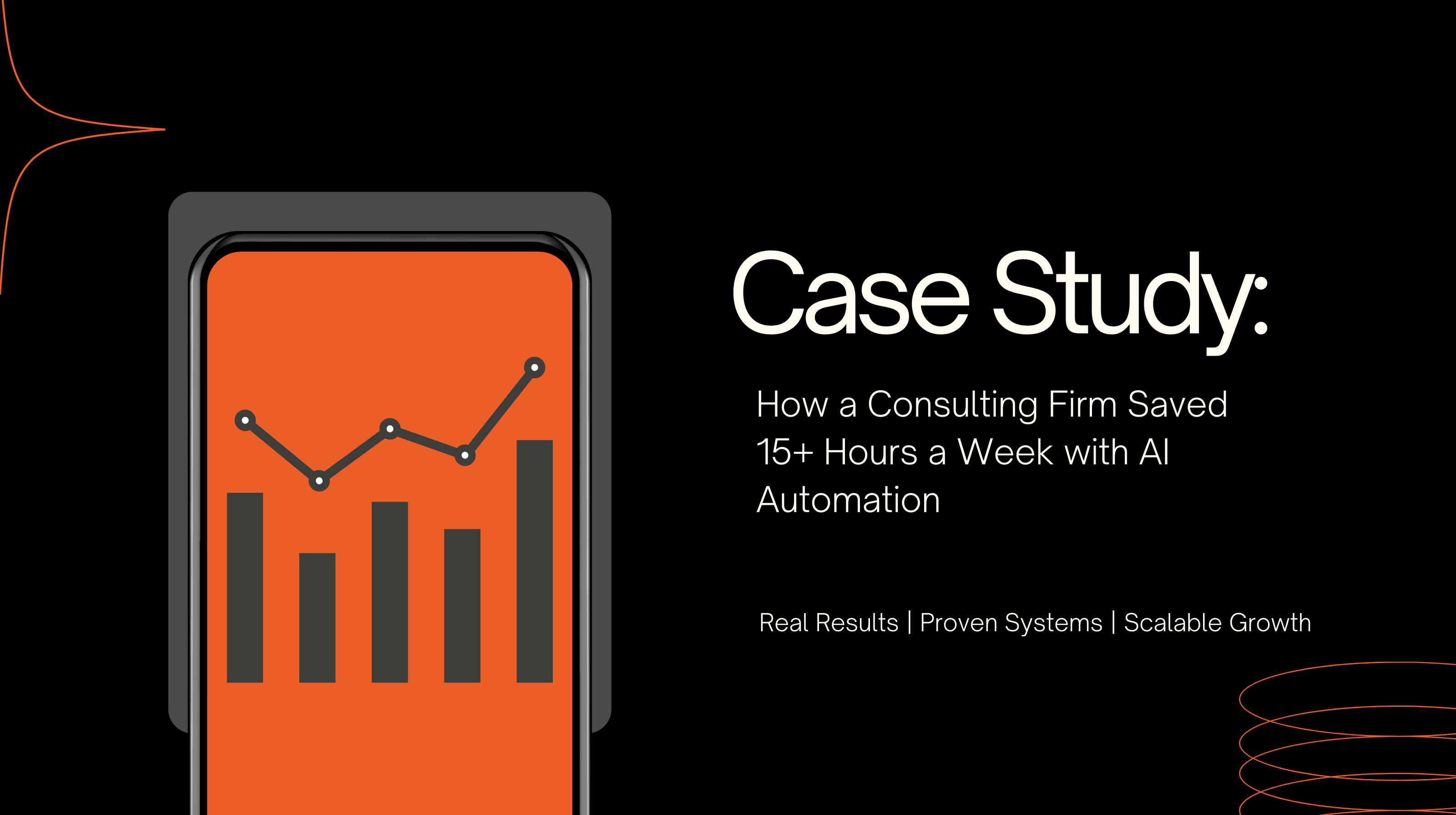Workflow bottlenecks slow down businesses, causing delays, missed deadlines, and frustration. Custom automation directly addresses these bottlenecks by streamlining processes, reducing repetitive tasks, and improving efficiency. Here's what you need to know:
Custom automation tailors solutions to your business, targeting specific inefficiencies. The result? Faster workflows, better resource use, and measurable improvements in productivity and cost savings.
S2 E20 Identifying Bottlenecks in Your Business: How to Pinpoint Areas Slowing Down Your Growth
How to Find Bottlenecks in Your Operations
Pinpointing bottlenecks in your operations requires a structured approach that blends data analysis with input from your team. The goal is to dig deeper than surface-level symptoms to uncover what’s truly slowing things down.
Process Mapping and Analysis
Process mapping is a great way to visualize how work flows through your organization. Start by documenting key workflows step by step, noting who’s responsible, what tools are used, and how long each step takes. This “as-is” map should reflect your current processes, even if some steps seem inefficient or outdated.
While mapping, pay close attention to single-person dependencies and manual handoffs. These are common culprits for delays. For instance, approval processes that require multiple sign-offs without clear deadlines often become bottlenecks.
A real-world example? A manufacturing company struggling with supply chain delays used process mapping to dissect its procurement workflow. By identifying unnecessary steps and automating parts of the process, they improved supplier communication and cut lead times in half - from 14 days to just 7. This change significantly reduced production delays.
The potential for improvement is enormous. Automating workflows could save employees up to 240 hours annually, and inefficiencies account for nearly 10% of every dollar spent by organizations.
Once your processes are mapped, keep an eye out for red flags that signal bottlenecks.
Warning Signs of Bottlenecks
Spotting bottlenecks early can prevent minor issues from snowballing into major disruptions. Here are some common warning signs:
Consider Tesla’s Model 3 production challenges in 2017. The company promised 1,500 vehicles in a quarter but managed to produce only 260 - just 17% of its target. Bottlenecks in battery module assembly, supply chain inefficiencies, and slower-than-expected production ramp-up at the Gigafactory caused delays that rippled through their entire operation.
Other signs to watch for include over-reliance on repetitive tasks that could be automated, poor communication between teams, and underutilized resources that aren’t being deployed efficiently.
Working with Your Team
While process mapping and data are critical, your team’s insights can reveal hidden issues. Frontline employees deal with the day-to-day realities of slow systems, unclear workflows, and communication breakdowns - problems that might not show up in reports.
Use tools like surveys, one-on-one interviews, or daily stand-ups to gather input. These conversations can highlight areas where team members face delays, duplicate efforts, or deal with frustrating inefficiencies. This feedback helps you understand the human toll of operational issues.
Skyler Badenoch, CEO of Hope for Haiti, shared:
"As an organization grows, communication starts to bottleneck. At Hope for Haiti, we've seen those inefficiencies hurt us: when we can't run like a well-oiled machine, we're not serving as many people as we could be - and it's our responsibility to improve upon that."
Involving your team in identifying problems and brainstorming solutions not only uncovers root causes but also fosters a sense of ownership. Techniques like the “5 Whys” can help dig deeper. For instance, if approvals take too long, ask why - does the delay stem from unclear criteria, missing stakeholders, or poor notification systems?
Collaboration can lead to big wins. In one case study, marketing teams that worked together on process mapping clarified roles, improved communication, and reduced campaign delivery times by 30%. Similarly, when development and support teams collaborated, customer response times dropped by 40%, and team morale got a noticeable boost.
Custom Automation Solutions That Remove Bottlenecks
Once you've pinpointed where bottlenecks are slowing down your processes, the next step is to implement automation solutions. The trick is selecting the right type of automation for each challenge - whether that means cutting down repetitive manual tasks, using AI to enhance decision-making, or building custom systems tailored to your workflow. Let's dive into how automation can transform routine tasks and drive efficiency.
Automating Repetitive Tasks
Routine tasks are a time sink. In fact, employees spend up to 28% of their workweek on tasks that could easily be automated.
"Automation isn't just about convenience anymore. It's become a business imperative for modern teams navigating complex workflows, tight deadlines, and rising expectations." - Linsa Saji
Take invoice processing, for example. By using OCR (Optical Character Recognition) technology, businesses can save hours of manual data entry each week. Automation tools handle everything from extracting and validating data to transferring it between systems. Similarly, automating approval workflows - like routing purchase orders based on pre-set criteria - can dramatically cut down cycle times. Even HR processes, such as onboarding, can be streamlined. Sending personalized emails, collecting documentation, and setting up accounts can all be automated, speeding up the process for new hires.
Research shows that 60% of all occupations have at least 30% of their activities that could be automated. Even partial automation allows employees to focus on strategic tasks, reduces errors, and boosts overall productivity.
But automation isn't just about routine tasks. AI takes things further by improving decision-making.
Using AI for Better Decisions
AI-powered tools excel at tackling complex problems, analyzing massive datasets, and offering real-time insights. They can identify patterns, predict trends, and optimize operations.
One standout example is predictive maintenance. BMW uses AI in its production facilities to monitor machinery health through sensors and machine learning. By spotting potential issues early, they avoid costly downtime and save both time and money.
AI also transforms supply chain management. IBM implemented AI-driven solutions within its own operations, saving $160 million and achieving a 100% order fulfillment rate during the height of the COVID-19 pandemic. Additionally, AI tools can reduce forecasting errors by up to 50% and cut lost sales from inventory shortages by as much as 65%.
Customer service is another area where AI shines. Sephora's virtual assistant, for instance, provides personalized product recommendations and automates basic support tasks. This reduces the workload on human agents while speeding up response times for customers.
AI is also making waves in quality control. One automaker implemented an AI-based visual inspection system that identified defects with 97% accuracy - far exceeding the 70% accuracy rate of human inspectors. In IT operations, Electrolux used AIOps to reduce issue resolution times from three weeks to just one hour, saving more than 1,000 hours annually by automating repair tasks.
Devcore's Leverage Blueprint™

While off-the-shelf automation tools can solve common problems, many businesses need custom solutions to address their specific workflows. That’s where Devcore's Leverage Blueprint™ comes in - a structured approach to identifying inefficiencies and building tailored automation systems.
The process starts with detailed workflow mapping to identify exactly where bottlenecks occur. From there, the Blueprint designs automations that integrate seamlessly with your existing systems.
A key focus area is CRM automation. This includes features like automated lead scoring, real-time updates from multiple data sources, and triggered follow-ups based on customer actions. These automations eliminate tedious manual tasks like data entry and status updates, helping sales and customer service teams move faster.
Custom dashboards and API integrations are another highlight. By pulling data from various systems into one place, these tools enable real-time monitoring and remove the need for manual data transfers.
Ultimately, custom automation goes beyond what generic tools can offer, addressing unique challenges and delivering solutions tailored to your business needs.
How to Measure Automation Results
Measuring the results of automation ensures that your custom solutions effectively address workflow bottlenecks. Implementing automation is just the first step - tracking its impact through well-defined KPIs is what uncovers the actual return on investment (ROI).
Key Metrics to Track
One of the first things to monitor is process time before and after automation. For instance, if invoice processing drops from 2 hours to just 30 minutes, that’s a 75% reduction in time. According to Gartner, businesses that automate high-volume tasks often see a 40–70% decrease in process times.
Another critical metric is error reduction. Automation can significantly cut down on mistakes. PwC reports that transactional processes experience a 50–75% drop in errors with automation. This is especially relevant in areas like data entry, financial calculations, and compliance-related tasks. Keep a record of errors, rework instances, and quality issues both before and after implementing automation.
Throughput improvements show how much more work your team can handle post-automation. A Deloitte survey revealed that 53% of organizations using multiple automation tools saw productivity increase by 20–30%. Track metrics like the number of orders processed daily, customer inquiries handled hourly, or reports generated weekly to gauge these improvements.
In regulated industries, compliance enhancements are key. Automation often improves audit outcomes, reduces regulatory violations, and ensures documentation accuracy. Automated systems typically generate reliable audit trails, which help minimize compliance risks.
Lastly, cost reduction provides a clear financial perspective. Calculate savings from reduced labor hours, fewer errors, and improved efficiency. McKinsey highlights that companies using business intelligence tools to track automation metrics achieve ROI that’s 30% higher than those relying on anecdotal evidence.
These metrics naturally pave the way for visualizing automation’s impact.
Before and After Comparisons
Visual comparisons help demonstrate the benefits of automation. Use side-by-side data to highlight key performance indicators before and after implementation.
Begin by establishing a 30-day baseline to collect pre-automation metrics. Then, compare these figures to post-automation results to clearly demonstrate improvements. For example, in a Deloitte case study, a logistics company reduced shipment processing time from 48 hours to just 30 minutes - a staggering 99% improvement - using robotic process automation (RPA). To illustrate your success, save screenshots of dashboards, detailed reports, and updated workflows. These visual aids not only validate your results but also strengthen the case for future automation investments.
Ongoing Monitoring and Improvements
Measuring automation results isn’t a one-time task; continuous monitoring is crucial. Gartner predicts that by 2025, 90% of large enterprises will adopt intelligent automation, but only 30% will scale successfully due to poor KPI tracking. To avoid falling into this trap, set up real-time performance tracking tools. Dashboards can help you monitor key metrics and quickly identify any performance dips, new bottlenecks, or shifting business needs.
"Continuous monitoring is essential for information security because it allows organizations to detect and respond to security threats in real time." – Emily Bonnie, Senior Content Marketing Manager, Secureframe
Regular reviews, whether monthly or quarterly, are essential for spotting trends and identifying areas for improvement. For example, are certain processes slowing down consistently? Are new types of errors appearing? Is the initial productivity boost starting to plateau? These insights can guide necessary adjustments.
As your business evolves, your KPIs should adapt too. Metrics that are critical today might be less relevant six months down the line. Document your findings thoroughly - what’s working, what isn’t, and which warning signs to watch for. This knowledge base will be invaluable when scaling automation to other parts of your organization or troubleshooting unforeseen issues.
Best Practices for Long-Term Automation Success
Once you've measured your automation results and pinpointed bottlenecks, it's time to focus on practices that ensure lasting efficiency. Long-term success doesn't happen by accident - it requires careful planning and execution. Companies that dive into automation without proper groundwork often find their early successes fading over time. The secret lies in taking a thoughtful, step-by-step approach that accounts for real-world challenges and evolving business needs.
Start with a Test Project
Pilot projects are your safety net against costly mistakes. Starting small helps you test assumptions, uncover potential issues, and fine-tune your strategy before making a larger investment. Begin with a stable, well-documented process for your first automation attempt.
For instance, a manufacturing pilot reduced application exceptions by 60% by focusing on targeted error handling and refining processes. This success highlighted the value of perfecting strategies on a smaller scale before rolling them out broadly.
When choosing your pilot, prioritize tasks where technology clearly outperforms manual efforts. Look for processes involving repetitive tasks, strict rules, or data-heavy operations prone to human error. Set clear success criteria and tie measurable outcomes to specific business goals.
Also, involve employees who work directly with the process you're automating from the start. Their input can reveal details that might be missing from documentation, help minimize resistance to change, and create internal advocates for your automation initiatives.
Plan for Special Cases
Automation isn't just about handling the standard workflow - it must also account for exceptions. Whether it's missing data, rush orders, or unexpected system downtime, exception handling ensures your automation remains effective and reliable.
Start by auditing your workflow. Document not only the typical steps but also edge cases, variations, and potential error conditions. This comprehensive understanding prepares your automation to handle real-world complexities.
Develop standardized workflows and reusable components for exception handling. For example, consistent error codes and messages across systems make it easier to recognize and address issues. Real-time monitoring and centralized logging systems are also essential for spotting exceptions as they happen and keeping a detailed record of automated activities. This visibility helps you identify trends and improve your system's resilience over time.
Schedule Regular Reviews
Automation isn't a "set it and forget it" solution. Regular reviews are necessary to ensure your systems keep up with evolving business needs and processes.
Plan quarterly reviews to evaluate performance against your original goals. Track metrics like time saved, error reduction, and cost savings to confirm you're still getting value. Use these reviews to identify new bottlenecks or opportunities to refine your workflows.
Technology evolves, and so do business models. What wasn't feasible to automate last year might now be possible. Similarly, shifts in market conditions may require adjustments to your automation strategy. Regular reviews help you stay ahead of these changes.
Feedback from daily users is equally important. Their hands-on experience can reveal inefficiencies or opportunities that data alone might miss. Document what's working, what's not, and any early warning signs to guide future improvements.
Finally, think about the ripple effects. Automation in one area can impact workflows in other departments. Regular reviews help you anticipate and address these impacts, ensuring your automation efforts align with broader business objectives without creating new inefficiencies. These reviews not only optimize current systems but also set the stage for scaling automation across your organization.
Conclusion: Building Efficient Operations
Custom automation has the power to reshape how businesses operate by eliminating bottlenecks that slow growth. In fact, over 90% of workers surveyed reported that automation tools significantly boosted their productivity, while 85% said these tools enhanced team collaboration.
Creating efficient operations starts with a thoughtful strategy. This involves identifying inefficiencies through detailed process mapping and implementing tailored automation solutions to address specific challenges. Together, these steps deliver tangible results, paving the way for immediate improvements and long-term success.
"Automation is an immediate way to improve efficiency and productivity across every department. The technology is no longer a 'nice-to-have'; it's a must-have, because automation tools improve both business and employee performance."
Automation doesn’t just improve productivity - it frees up nearly 80% of employees to focus on more meaningful tasks, like strengthening customer relationships and developing new skills. However, the work doesn’t stop there. To keep up with evolving needs, businesses must continually refine their systems. Regular reviews ensure automation adapts to changing demands, while ongoing monitoring helps uncover fresh opportunities for improvement. As Juan Perez highlights, automation that optimizes processes and enables personalized engagement at scale transforms both employee and customer experiences.
FAQs
How can businesses identify which workflows are ideal for custom automation to eliminate bottlenecks?
To pinpoint workflows that are ideal for custom automation, businesses should begin by examining major challenges like prolonged cycle times, recurring delays, or repetitive tasks. Gathering input from employees and analyzing performance metrics can shed light on the areas where inefficiencies stand out the most.
After identifying these bottlenecks, mapping out the entire workflow can help clarify where automation would be most effective. Pay particular attention to processes that consume a lot of time, are prone to errors, or require significant resources. Tackling these areas can help businesses simplify operations, reduce wasted time, and boost overall productivity.
What steps should a company take to successfully implement custom automation solutions?
To put custom automation solutions into action, start by pinpointing the exact bottlenecks or inefficiencies slowing down your workflows. Set clear, measurable goals - whether it’s cutting down on time, reducing mistakes, or boosting scalability.
Take a deep dive into your current processes to see where automation can make a real difference. Tools like process mapping or data analysis come in handy here, helping you zero in on areas that need improvement. With this understanding, design a solution tailored to your business goals. Before rolling it out fully, test and tweak the system to ensure it works as intended and meets your expectations.
Following this approach allows businesses to build automation systems that solve their specific challenges and deliver impactful results.
How can businesses evaluate the success and ROI of custom automation in solving workflow bottlenecks?
Businesses can gauge the success and ROI of custom automation by focusing on measurable outcomes like time savings, fewer errors, and better process efficiency. Key performance indicators (KPIs) such as higher throughput, lower operational costs, and greater customer satisfaction often shed light on how automation is making an impact.
To dig deeper, companies can monitor both quantifiable metrics - like cost reductions and hours saved - and qualitative improvements, such as enhanced employee productivity and improved customer experiences. By tying these metrics to their business objectives, organizations can assess how well automation resolves workflow challenges and delivers tangible results.
Related posts
- Manual Workflows Slowing Growth? AI Solutions
- Ultimate Guide to Scaling Business with Automation
- How to Measure Automation ROI: 6 Key Metrics
- Custom Automation for Operational Efficiency: Success Stories
{"@context":"https://schema.org","@type":"FAQPage","mainEntity":[{"@type":"Question","name":"How can businesses identify which workflows are ideal for custom automation to eliminate bottlenecks?","acceptedAnswer":{"@type":"Answer","text":"<p>To pinpoint workflows that are ideal for custom automation, businesses should begin by examining major challenges like prolonged cycle times, recurring delays, or repetitive tasks. Gathering input from employees and analyzing performance metrics can shed light on the areas where inefficiencies stand out the most.</p> <p>After identifying these bottlenecks, mapping out the entire workflow can help clarify where automation would be most effective. Pay particular attention to processes that consume a lot of time, are prone to errors, or require significant resources. Tackling these areas can help businesses simplify operations, reduce wasted time, and boost overall productivity.</p>"}},{"@type":"Question","name":"What steps should a company take to successfully implement custom automation solutions?","acceptedAnswer":{"@type":"Answer","text":"<p>To put custom automation solutions into action, start by pinpointing the exact bottlenecks or inefficiencies slowing down your workflows. Set clear, measurable goals - whether it’s cutting down on time, reducing mistakes, or boosting scalability.</p> <p>Take a deep dive into your current processes to see where automation can make a real difference. Tools like process mapping or data analysis come in handy here, helping you zero in on areas that need improvement. With this understanding, design a solution tailored to your business goals. Before rolling it out fully, test and tweak the system to ensure it works as intended and meets your expectations.</p> <p>Following this approach allows businesses to build automation systems that solve their specific challenges and deliver impactful results.</p>"}},{"@type":"Question","name":"How can businesses evaluate the success and ROI of custom automation in solving workflow bottlenecks?","acceptedAnswer":{"@type":"Answer","text":"<p>Businesses can gauge the success and <strong>ROI</strong> of custom automation by focusing on measurable outcomes like <strong>time savings</strong>, <strong>fewer errors</strong>, and <strong>better process efficiency</strong>. Key performance indicators (KPIs) such as higher throughput, lower operational costs, and greater customer satisfaction often shed light on how automation is making an impact.</p> <p>To dig deeper, companies can monitor both <strong>quantifiable metrics</strong> - like cost reductions and hours saved - and <strong>qualitative improvements</strong>, such as enhanced employee productivity and improved customer experiences. By tying these metrics to their business objectives, organizations can assess how well automation resolves workflow challenges and delivers tangible results.</p>"}}]}




